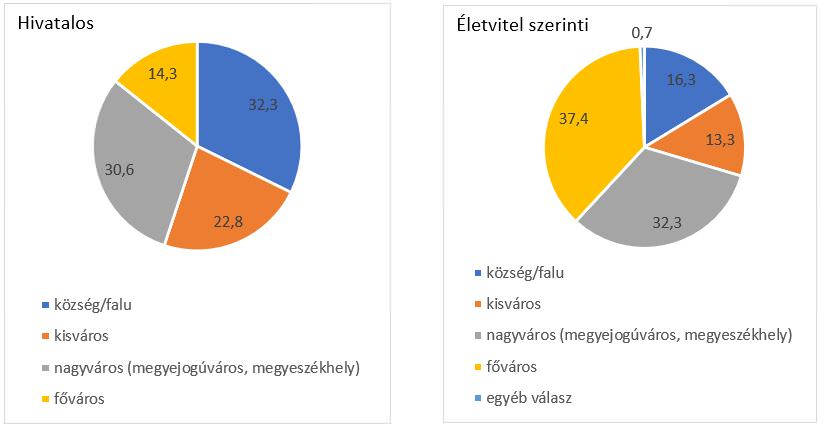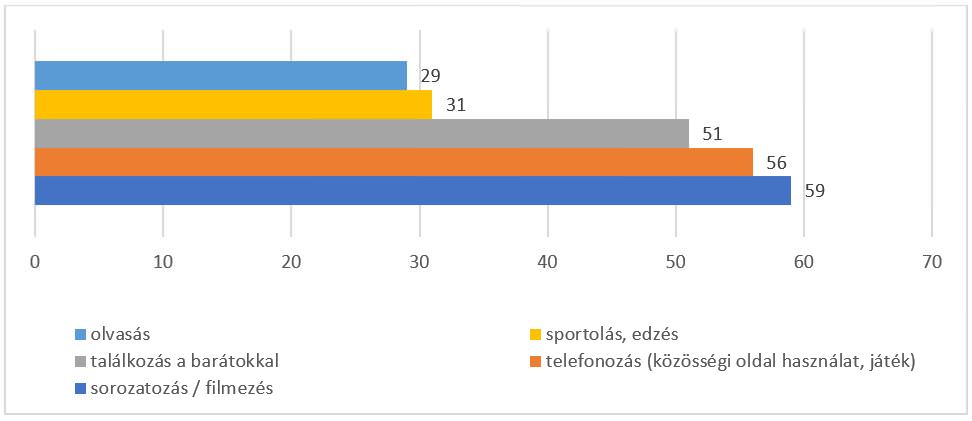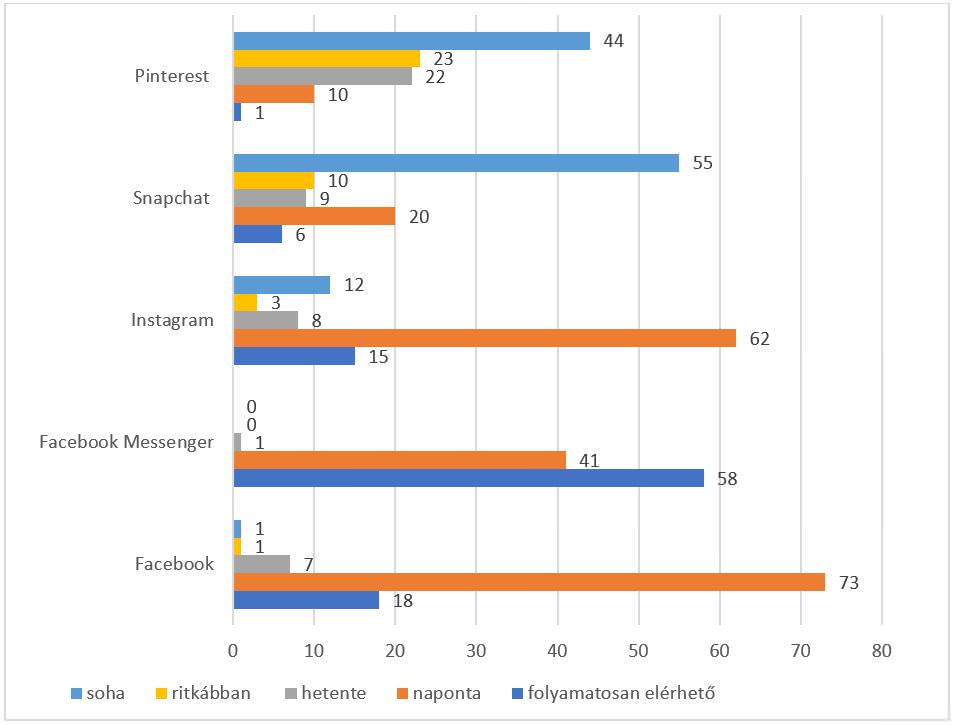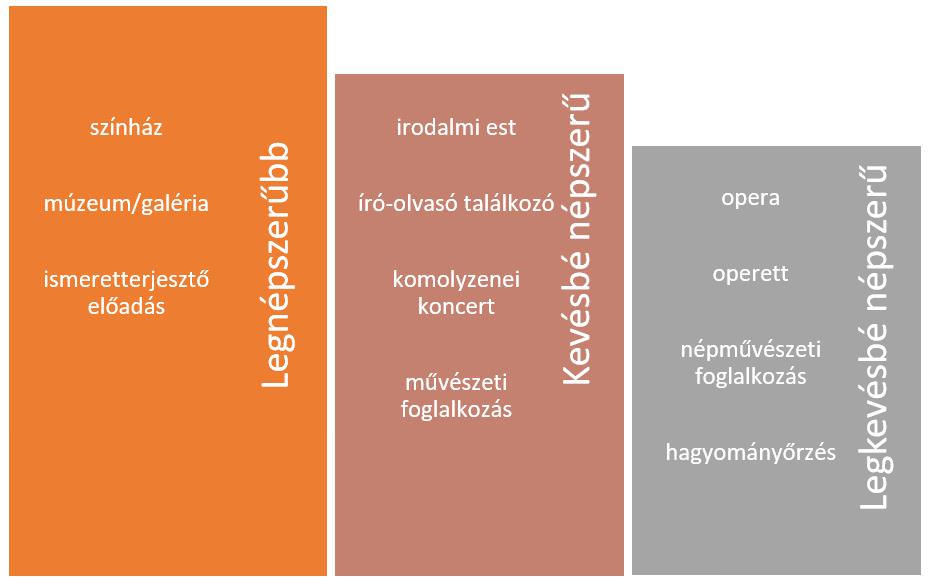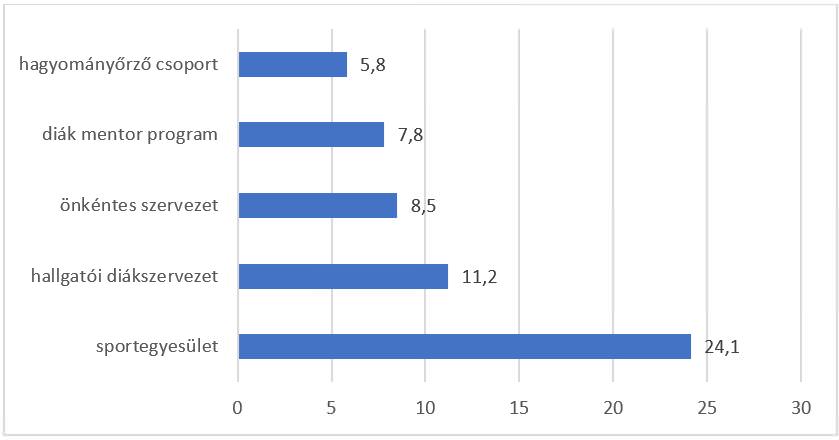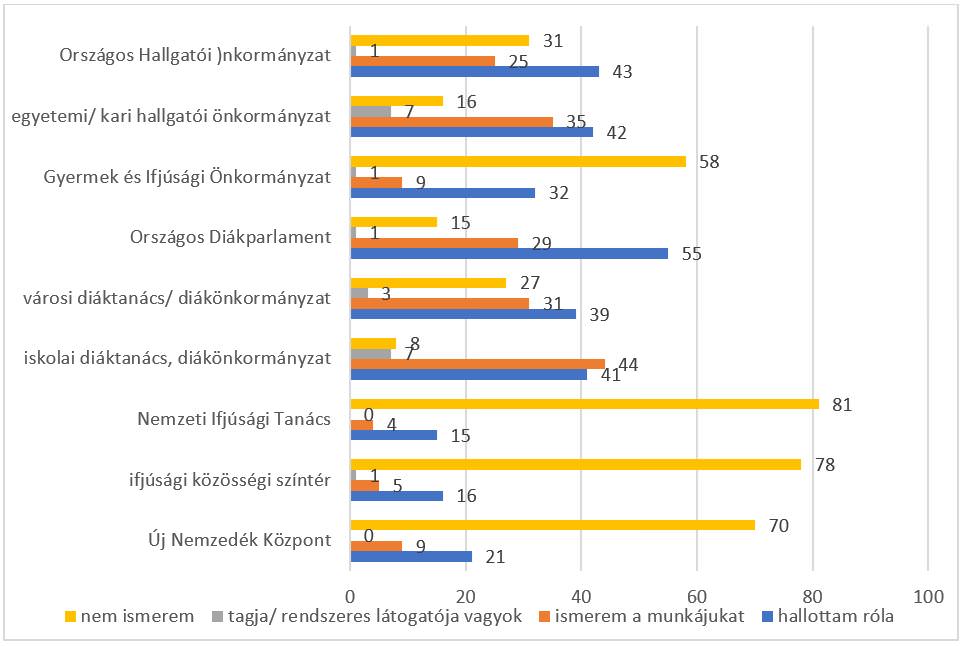Edina Mohos – László Ponyi: Leisure time use and culture consumption habits of the youth
Cikk letöltése: pdf2021-04-01

Abstract: In our quickly changing world the cultural changes and technological innovations may have a great impact on the youth. Therefore, we think the social characteristics differ. The purpose of the study is to demonstrate the attribution of recreation and cultural consumption habits of this generation. We aspired to determine the major traits of the juvenility based on literature and pre-existing researches. Our goal was to create a broader picture of the youth, which can be useful for community cultural areas and can help the work of the professionals.
The theoretical background of the study
In the article we defined the youth age group based on the humanities and natural sciences among other things. We can interpret a person's level of maturity from a biological, psychological and sociological point of view, however, due to different interpretations between scientific fields, it is not possible to create a unified definition. In our study, we deal with the age group between 15-29 years of age.
In Stumpf's interpretation, youth is the phase of the development of intellectual and social abilities, when the individual is not yet independent, not fully autonomy, because his sense of responsibility and the value and norm system are not yet stable. (Stumpf, 1992) Erik Erikson's theory of development (Erikson, 1950) is crucial from a psychosocial point of view. In his opinion, the transition between different developmental phases is not always easy and the individual is not always able to move to the next stage of life. This interpretation suggests that the period from birth to adulthood is extremely unique and many factors influence its development, so the classification is based on the development of the individual and the situation of life. (Nagy et al, 2014; Kabai et al, 2018)
The definition of a unified concept is further complicated by the new age group paradigm that emerged a couple of years ago as the result of the service society, i.e. between childhood and adulthood the post-adolescent period was wedged. The life stages today no longer follow each other in a linear fashion, in some cases they are extended, interchanged, and there are overlaps, for instance in the areas of their studies, employment, marriage and starting a family. (Zinnecker, 1982) The emergence of this period is due to the extension of studying, which is associated with the lengthening of childhood and parental support, especially in the financial sense. (Andorka, 2003) Thus, the most important characteristics are that in this transitional period they are not completely independent from the parental home, young people are psychologically and biologically mature, but not independent in a social and financial sense. (Zinnecker, 1982; Vaskovics, 2000) Referring to Erik Erikson's theory, the point of the life stage is that the individual could acquire the knowledge, qualifications, and conditions necessary to reach the next category. The post-adolescent period, also known as post-puberty, also influences the leisure and socialization habits of young people. Due to the individual different situations of life and alternating life stages, it is not possible to precisely define the youth. (Andorka, 2003)
According to Murányi's 2006 explanation of the concept, socialization is a process, with the result that the individual acquires some kind of knowledge or skills, and his personality develops, his different attitudes, his self-knowledge, and self-awareness are strengthened. (Muranyi, 2006) All of these qualify the youngster to be able to fulfill social roles, to integrate and prosper in community life. Its most important tool is the interaction with the environment, as different interactions shape the individual. (Nagy et al, 2014) Internalization is also related to socialization, which is the process during which the individual identifies himself with norms and values to such an extent that his behavior develops along these lines even without external influences. (Andorka, 2003) Primarily, we can distinguish three environments that comprise the elements of socialization, however, as a result of the current modern society a new, independent space emerged. The importance and role of the environment changes continuously with the progress of the individual's age, the norms and values of childhood can be reinforced or transformed by the new effects associated with the change, so a resocialization can occur in the individual's life. (Andorka, 2003) The family (primary) helps the individual to develop basic behavioral norms, the school and the workplace (secondary) support the formation of the vision of the future, peer groups (tertiary) represent individual freedom and provide opportunities for self-fulfilment. The components of the media space (quaternary) are the world of the Internet and mass communication. It appears in more areas than the other three socialization mediums, because in addition to the transmission of culture, its contact maintaining, informational, entertainment and persuasion functions are also relevant. The value-transmitting and orienting role of the school and the family is declining, the media, stars and opinion leaders (influencers) are the most important and most authentic points of reference for the young generations. (Horkai, 2004) We believe that the reason why the online world is significant is because its effect lasts life long, and it can influence the other three basic socialization agents as well.
The concept of free time was first defined by Aristotle. In his interpretation, it represents the time when human virtues unfold, during this time, the individual deals with what she likes, this is the concept of remaining time. Nowadays, we can talk about a leisure-time society, in which the time aspects and the sharp boundaries between productive and unproductive activities have disappeared, therefore qualitative leisure time has come to the front instead of quantitative leisure time. (Nagy et al, 2014) Different categories can be formed within the concept of leisure time, such as social (family, company, social) and individual activities. (Nagy et al., 2014) In terms of out study, the most important model is Iván Vitányi's typology of leisure time use based on behavior. Based on this, we distinguish passive, recreational, accumulative and inspirational leisure time. (Vitányi, 1995) The first two categories basically represent relaxing, entertaining activities that require little energy, while the other two stand for time spent with self-development and using high culture in different fields of interest either permanently or as a try-out. (Nagy et al, 2014) The previously mentioned new era, i.e. post-adolescence, also had an impact on the transformation of the leisure scenario of young people. This scenario formed the consumer status of the youth, which was strengthened by economic and technological developments, thus they become participants in the market earlier compared to previous trends. (Gábor, 2004) In the current postmodern society, the school system is becoming more and more differentiated, along with this, in most cases, individual socialization does not take place in institutionalized form. That is why it is important to focus on out of school life in terms of view of culture, education and transmitting values. (Balázsi, 2017) According to Fekete and Tibori, the "leisure trinity" has been created, which means tim spent on the Internet, watching television and with friends (even online). (Tibori Fekete, 2018) We believe that television is nota s significant among young people as it was at the time whne the the quoted articles were written. Due to the continuous development of technology, other new electronic applications distract their attention.
Regarding the youth, participation is essential for their social integration, their development as a responsible person and the enforcement of their interests. (Large, 2008) As for involvement and activation, the key concept is cooperation instead of being managed by authority, since young people are experts in their own situation, so their opinions and thoughts are extremely important. The different programs and jobs must be tailored to the special characteristics of the youth, such as their time schedule, this way, activation can be more effective. (Nagy-Szabó, 2018) Young people can be connected with mostly at their homes, in their friends' circles, they can be addressed in such environments. (Russian Monostori, 2018)
Empirical research
The study aimed to create a comprehensive analysis covering several topics, with the help of which we can get closer to the youth. The starting points of the study were the following hypotheses:
- The majority of the youth can be characterized by features of the post-adolescent period, that they find it more difficult to make commitments, they postpone the period of becoming adults, and these also affect their leisure and socializing activities.
- For young people, the point of quality free time is not the activities, but the company. They consider the time spent with friends quality free time, they are active and approachable in this environment.
- Young people do not shy away from learning about traditions and culture, despite the fact that innovation and modernity are important to them.
The sample and demographic details
Based on the previously discussed theoretical foundations and conceptual approaches, the 15-29 age group were involved in the study. The target group was surveyed with an online questionnaire, which was completed by 294 respondents.
Among them, 20-24-year-olds, women and those with a certicate of secondary education were overrepresented. At the time of the survey (25.02.2020-16.03.2020), 82.3% of the respondents were enrolled students, and the majority also worked part-time or full-time. Based on the collected data, young people are characterized by relocation, usually from small settlements to the capital or county seats in the hope of more opportunities. The majority of those surveyed (69.7%) live in the capital, large cities or county seats, but their official residence is typically (55.1%) in small settlements, i.e. in villages, or small towns. (Figure 1)
Figure 1: Young people's official place of residence and their actual residence (%)
N=294
(Source: Author, 2020)
Apart from getting to know the general characteristics, this chapter aims to verify the validity of the first hypothesis, i.e. the post-adolescent life stage. The questions focused on the young people's future plans and their intentions to become independent. 66.3% of the representatives of the age group definitely want to go on with their studies in the next 5 years, and if we also consider those answering "maybe", a total of 90% are thinking about it. The potential of starting a family and getting married is planned as late as possible, at the average age of 28 and 26.6. This trend is associated with the extension of young adulthood, which is one of the main characteristics of the post-industrial society. Furthermore, the answers also revealed that the majority of young people are strongly dependent on their parents, at least financially. Postponing commitment and becoming an adult is also proven by the fact that half of the age group are single, on average 21-year-olds answered so, which means that this status is largely a characteristic of adults. The difficulty of becoming independenct is supported by the statistics, according to which the majority live with their parents, only 16 of them live alone, 45 with their partner, and 69 respondents with contemporary roommates.
Plans for the future showed a similar pattern in the past year as well, confirming the prolongation of the age of the youth, thus, we can talk about a social transformation lasting several years. (Ádám et al, 2013; Bauer et al, 2017; Bene et al, 2018) Getting to know the characteristics of the age group is essential in the field of cultural education, as ideal and attractive services must be provided for them in accordance with their life situation, which also makes it easier to address them.
The use of leisure time
From the point of view cultural education, it is essential to consider the leisure time habits of the youth as this can help us map their interests. The study enquired with whom they regularly spetd their free time and which type of free time best characterizes them.
The answers show that, young people on average have more free time at weekends, the majority has more than 4 hours, while on weekdays they only have maximum 2-4 hours. Thus, the majority of the age group has at least a small amount of free time besides school and other duties. The answers reflect that regarding the environment for socialization, the group of contemporaries and friends clearly dominates, followed by the family in the second place, however, some contradictions can also be found in the results. Amongst other things, the fact that the number of hours they spend online per day is significantly more than the time they can use freely. This leads to the conclusion that young people cannot separate their quality time and ad hoc free time. Studying the Internet usage habits, we can conclude that young people have more free time, but the different online options occupy most of the hours that can be spent freely. Furthermore, in terms of activities, most of the respondents perform various activities alone in most cases, they rarely organize programs with their friends and family. This statement is also confirmed by the conclusions of previous large-scale youth research studies, according to which young people are characterized by spending their leisure time and consume content solitarily. (Ádám et al, 2013; Bauer et al, 2017; Bene et al, 2018)
The study separated the most popular leisure activities and programs organized with friends (Figures 1-2). While reading, training and various online activities appeared in the former, among the activities performed in the company of friends going to the movies and talking in various catering facilities is remarkable. Respondents could mark several entertainment options. Their favorite leisure activities are phoning (56%), watching series/filming (59%) as well as spending time with friends (51%) (Figure 2), however they also prefer to talk with friends in cafes and restaurants (69%), or go to pubs and clubs (55%). (Figure 3)
Figure 2: Leisure activities the youth are most often involved in(%)
N=294
(Source, Authors, 2020)
Figure 3: The three most popular activities with friends (%)N=294 (Source, Authors, 2020)

The majority of young people basically spend much more time online than actually with using the phone. The majority are available online for 5-8 hours or even all day, while on average they spend only 1-4 hours with the device itself. The great deal of or continuous availability means that they are able to switch during any action, to be withdrawn by a message, so they do not get immersed in a specific situation. In 2016, 88% of youth used the online platforms on a daily basis (Bauer et al, 2017; Bene et al, 2018); four years later, this proportion among those surveyed was 100%. 71.8% of the sample believes that they spend too much time on their phones.
Different social media platforms are present in the everyday life of the young people. Almost every page is important for the age group for one function or another, as some are mostly for keeping in touch, others for dating and there are also some for getting information. Various opinion leaders and role models also appear on these platforms, who usually promote some products, services or activities among theiy followers. In Hungary there are influencers (yet sparsely) who promote cultural content, they usually encourage youngsters to read books and attend theater performances. The judgement of the influencer marketing is divided among the respondents. 50.7% follow such people, while the rest completely refuse this phenomenon. In terms of cultural education, this can be a good means of involvement, we must consider that this type of marketing method is not attractive to everyone and it can even be revolting. In the world of the social media, Facebook group applications are the most popular.
The popularity and user frequency of the various social networking sites are shown in the figure below. (Figure 4) Messengeris the mostly used, 58% are constantly, another 41% are available on a daily basis. The application is to maintain contact, it is practical thanks to the easy exchange of messages and due to the possibility of immediate responses, it creates conversation seems to be live. Based on the results, the second most popular is Facebook itself, and the third is Instagram. Apart from maintaining contact, these two platforms also make it possible to get information about each other, programs, and the world.
Figure 4: Frequency of use of social networking sites (%)
N=294
(Source: Authors, 2020)
Consumption of Culture
After the change of the regime, high culture was pushed into the background by mass culture (Hunyadi, 2005), thus the culture-loving layer is getting older. (Kuti, 2009) One of the main reasons for the transformation of the attitude to culture is digitization (Bauer et al. 2017), in this context it can be stated that a significant majority of young people prefer modernization over following tradition. (Ádám, et al. 2013)
The results show that young people only rarely or occasionally visit cultural institutions. The most popular institution in their circles is the cinema, but most of the respondents have never been to an art cinema to watch artistic films. Going to the cinema is a popular program among friends’ circles, more than 84% of young people watch a movie at least once a year, but most of them go to the cinema several times or more during a term. Members of this age group rarely consume high culture, in their case theater performances are the most popular and they are the most frequent activities (it has not changed since 2016). (Figure 5 In contrast to the hundreds of cases taking place in the other options, only 5 of the respondents had never been to a theater performance before. However, its attendance is not very frequent, as youngsters usually see a performance once a year or less frequently. The findings indicate that they go to museums more often than to cultural centers, mostly once or twice a year. One of the most popular leisure activities is reading. The majority of the respondents prefer bookstores to libraries, where they usully go only for materials needed for the school assignments. (Figure 5 All this suggests that modern, easy-to-consume content is more popular among the youth.
Figure 5: Frequency of visits to cultural transmitting institutions (%)
(Source: Author, 2020)

Figure 6: Popularity of cultural programs ranked by the youth
N:294
(Source: Authors, 2020)
Thus, the third hypothesis (in which we assumed that young people do not shy away from traditions and culture, despite the fact that modernization and innovation are important to them) was refuted, since a significant majority of the surveyed young people ranked traditions and classical cultural programs to the end of the list.
Unfortunately, the downward trend of cultural consumption measured by previous large-scale research did not stop. (Ádám et al. 2013; Bauer et al. 2017; Bene et al. 2018) Although young people have enough free time that they could spend on quality programs, they still prefer to consume digital contents, relaxing and options where they are entertained.
Public life
According to research from recent years, the membership rate of Hungarian young people in organizations does not reach the average of the EU, as even the most popular ones have a membership rate of only 10%. (Ádám et al. 2013; Bauer et al. 2017; Bene et al. 2018)
The table below shows the percentage of memberships in organizations. (Figure 7) 73.9% of the interviewed young people are not at all active in the community life of their settlement. This is also the case with volunteering, which 51.7% of the youth do not do at all, and 34.4% do so only very rarely, and the permanent membership of voluntary organizations is also low. It is interesting that although tradition preservation is the least attractive activity among young people, yet it appears among the five most popular organizations when it comes to membership. (Figure 7)
Figure 7: Membership rate of young people in various organizations (%)
(Source: Authors, 2020)
The survey also reveals that the majority of young people do not even know about civil organizations, in many cases not even those that are specifically aimed at their age group. The majority had not even heard of the New Generation Center (70%), nor of the National Youth Council (81%) or of any other youth community space (78%). (Figure 8)
Figure 8: Being informed about youth organizations and facilities (%)
N=294
(Source: Authors, 2020)Among the age group, the most well-known types of organizations are student organizations, school/university/city student governments and councils, but their membership rate is also low.
Summary
The results indicate that the majority of young people have certain general characteristics and habits due to their living situation. At this age, it is not incidental that friends and the media dominate as opposed to community and social actions, as this is mainly due to the psychosocial characteristics of the age group. We would like to point out that the study is not representative due to the size and composition of the sample.
It is not easy to define the concept of the youth due to the reversibility of life paths, and the emergence of the post-adolescent life stage further complicates this. The results of the research confirm the theory, reveal the general situation of the youth and confirm that examining individual life paths is inevitabile. Regarding the first hypothesis, we can state that young people are following a different life path compared to earlier times, which is accompanied by the prolongation of adolescence lacking complete independence. [1] The main reason for this is the postponement of their studies, which also determines socialization environments and leisure habits.
In terms of socialization, the media space is extremely important for the age group, as it appears in all areas of their lives. The accelerated digitization caused by the coronavirus presumably strengthened this phenomenon, that is why it is important to deal with this socialization medium. When we think about the youth from a professional point of view, we have to use some kind of digital or innovative tools, as we can keep in contact with them through these channels. The results also show that the Internet dominates leisure activities, as the majority of young people spend hours using their devices and they prefer light entertainment requiring minimum of their energy, for which the internet is an optimal choice. In addition to the use of modern channels, the way to address and activate young people is through their contemporaries. The presence of friends and spending free time with them confirms the second hypothesis, according to which spending quality time lies more in the company than in the action itself. The dominance of friend circles can be observed and a greater interest in student organizations Despite all this, membership in organisations is not outstanding, because institutionalized leisure activities are not attractive for the age group, and most of the time the communication of the organizations does not reach the members of the age group. Based on the results, we can conclude that young people can be reached mostly in educational institutions, in their own micro-environment and among their peers.
The study also revealed that, despite our prior assumptions, young people turn away from traditions and a certain part of culture. They clearly believe in modernization and innovative solutions, which distracts their attention from cultural values and programs. Thus, the third hypothesis was refuted. Passing on traditions in a modern form and applying various spectacular digital possibilities can be a solution to this problem. A good example of this is the slam poetry presented above, which started as a bottom-up initiative generated by young people to modernize poetry and self-expression.
Getting to know and understanding the behavior, motivational system, and leisure habits of young people is essential for the cultural education profession. Providing the suitable programs and opportunities is only possible if we know, listenin to and involve the age group. This study aims to help professionals with this.
References
- Ádám, S., Domokos, T., Gazsó, T., Kitta, G., Makay, Z., Nagy, Á., . . . Székely, L. (2013). Magyar ifjúság 2012 tanulmánykötet. [The Hungarian Youth 2012 volume](L. Székely, Szerk.) Zotter Judit.
- Andorka, R. (2003). Bevezetés a szociológiába. [Introduction to Sociology] Budapest: Osiris Kiadó.
- Balázsi, K. (2017). Idő és rend a közösségi művelődésben. [Time and order in community culture] Lakitelek: Antológia Kiadó.
- Bauer, B., Pillók, P., Ruff, T., Szabó, A., Szanyi F., E., & Székely, L. (2017). A Magyar Ifjúság Kutatás 2016 első eredményei: Ezek a mai fiatalok![The first results of The Hungarian Youth 2016 survey. These are the present day youth.] (L. Székely, & A. Szabó, szerk.) Ekler Gergely.
- Bene, V., Boros, L., Bozsó, H., Csákó, M., Csizmadia, Z., Diósi, P., . . . Tóth, P. (2018). Margón Kívül - magyar ifjúságkutatás 2016 Outside the margin - The Hungarian Youth study 2016]. (Á. Nagy, Szerk.) Excenter Kutatóközpont.
- Erikson, E. (1950). Growth and crises of the "healthy personality.". In M. J. (Ed.), Symposium on the healthy personality (old.: 91-146). Josiah Macy, Jr. Foundation.
- Fekete, M., & Tibori, T. (2018). Az ifjúság szabadidőfelhasználása a fogyasztói társadalomban. [The use of the leisure time among the youth in the consumer society.] In V. Bene, L. Boros, H. Bozsó, M. Csákó, Z. Csizmadia, P. Diósi, . . . Oros, & Á. Nagy (Szerk.), Margón Kívül: magyar ifjúságkutatás 2016 (old.: 258-283). Budapest: Excenter Kutatóközpont.
- Gábor, K. (2004). Globalizáció és ifjúsági korszakváltás. [Globalization and the change of the youth era.]Belverde Meridionale (old.: 28-72). Szeged: Fővárosi Szabó Ervin Könyvtár, MTA Szociológiai Kutatóintézet, Professzorok Háza Felsőoktatáskutató Intézet, Magyar Szociológiai Tűrsaság Ifjúságszociológiai Szekció, Ages Quod Agis Kht., Hálózat a Szabad Információért Alapítvány, SETUP Alapítvány.
- Horkai, A. (2004). Screenagerek, Kultúrák közötti kommunikáció az iskolában. [Screenagers, Communication between cultures in schools] Belvere Meridionale. Ifjúsági korszakváltás: Ifjúság az új évezredben: Konferencia 2002. december 18., old.: 122-139. Szeged: Fővárosi Szabó Ervin Könyvtár, MTA Szociológiai Kutatóintézet, professzorok Háza Felsőoktatákutató Intézet, Magyar Szociológiai Társaság Ifjúságszociológiai Szekció, Ages Quod Agis Kht., Hálózat a Szabad Információért Alapítvány, SETUP Alapítvány.
- Hunyadi, Zs. (2005). Kulturálódási és szabadidő eltöltési szokások, életmód csoportok. [Culture consumption and leisure time habits, lifestyle groups] Budapest: Magyar Művelődési Intézet.
- Kabai, I., Iharosi, T., & Kabainé Tóth, K. (2018). A társadalmi rétegződés empirikus vizsgálata a fiatalok körében egy speciális többdimenziós modell segítségével. [Empirical investigation of social stratification among the youth using a special multidimensional model.] In V. Bene, L. Boros, H. Bozsó, M. Csákó, Z. Csizmadia, P. Diósi, . . . P. Tóth, & Á. Nagy (Szerk.), Margón Kívül: magyar ifjúságkutatás 2016 (old.: 372-401). Budapest: Excenter Kutatóközpont.
- Kuti , É. (2009). A kutlúra iránti érdeklődés és a kultúrafogyasztás alakulása a Nemzeti Médiaanalízis adatai alapján. [The trends in intrest in culture and culture consumption based on data from the National Media Analysis.]In T. Antalóczy, L. Füstös, E. Hankiss, & E. Hankiss (Szerk.), (Vész)jelzések a kultúráról (old.: 151-200). Budapest: MTA PTI.
- Murányi, I. (2006). Identitás és előítélet. [Identity and Prejudice.] Budapest: Új Mandátum Könyvkiadó.
- Nagy, Á. (2008). Ifjúságügy, ifjúsági szakma, ifjúsági munka. [Youth affairs, youth profession, youth work.](Á. Nagy, Szerk.) Budapest: Palócvilág Alapítvány, Új Mandátum Könyvkiadó.
- Nagy, Á., & Szabó, J. (2018). Motiválás a közösségi művelődésben és az ifjúság bevonása. [Motivation in community culture and the involvement of the youth.] Budapest: NMI Művelődési Intézet Nonprofit Közhasznú Kft.
- Nagy, Á., Bodor, T., Domokos, T., & Schád, L. (2014). Ifjúságügy. [Youth affairs](Á. Nagy, Szerk.) Budapest: ISZT Alapítvány 2001, Enigma Kiadó 2001.
- Oross, D., & Monostori, K. (2018). Gondolkodj globálisan, cselekedj lokálisan![Think globally, act locally]- Ifjúságügy és civil világ. In V. Bene, L. Boros, H. Bozsó, M. Csákó, Z. Csizmadia, P. Diósi, . . . Oros, Margón Kívül: magyar ifjúságkutatás 2016 (old.: 350-371). Budapest: Excenter Kutatóközpont.
- Stumpf, I. (1992). Az ifjúság problémák értelmezése - Ifjúsági kihívás az ezredfordulón. [Interpretation of youth problems - Youth challenge at the turn of the millennium.] In L. Boros, T. Pál, K. Gábor, L. Laki, J. Rácz, I. Harcsa, C. Fazekas, P. Gazsó, & Stumpf István (szerk.), Rendszerváltozás és ifjúság (old.: 9-12). Budapest: MTA Politikai Tudományok Intézete.
- Vaskovics, L. (2000). A posztadoleszcencia szociológiai elmélete. [The sociological theory of post-adolescence.]Szociológiai Szemle. Forrás: https://szociologia.hu/dynamic/0004vaskovics.htm
- Vitányi, I. (1995). Társadalmi idő- szabadidő, a szabadidő új problémái a társadalomban. [Social time - free time, new problems of free time in society.] In I. Vitányi, Szabadidős és társadalmi átalakulás. Budapest: Magyar Szabadidő Társaság.
- Zinnecker, J. (1982). Jugend 1981: Porträt Einer Generation. In J. Zinnecker, Jugendwerk der deutschen Shell (eds) Jugend '81 (old.: 80-122). Weisbaden: VS Verlag für Sozialwissenschaften.
[1] See the hypotheses in the introductory part of the empirical research chapter.

